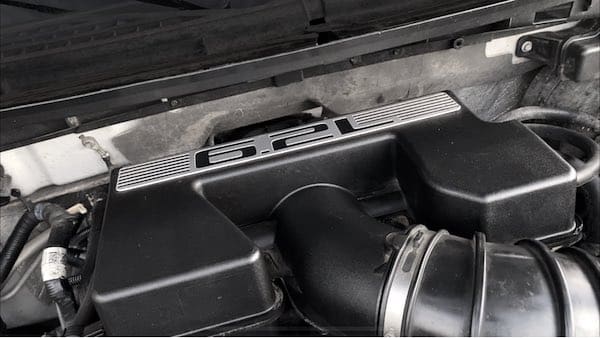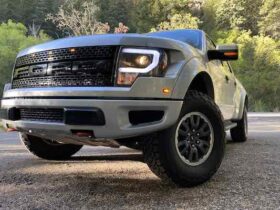Our Research on Ford Raptor Performance Upgrades
We did a ton of research on Ford Raptor performance upgrades and built a “Horsepower Price index” (or HPI) that tells you the best cost per horsepower you can spend on your Ford Raptor performance upgrades.
Our categories are intakes, exhaust, forced air induction (turbos or superchargers), throttle bodies and custom tunes.
We scoured the internet for HP results based on dyno numbers for these popular truck mods, verified the costs for each of those upgrades and then created what we call our HPI (Horsepower Price Index) that tells you how much it costs for every HP increase per upgrade. Bank for you buck is not about the highest horsepower gain but how far each dollar goes to give your truck more power.
A Bit About Horsepower
Horsepower numbers in this auto industry are often inflated numbers advertised by the manufactures to make you buy their product. They get away with it because it’s not an exact science but it is about mathematics and physics. HP is a result of the power that is extracted from Chemical Energy (in the form gasoline and air) when ignited and that energy is transformed into mechanical energy.
We try to debunk or validate those numbers by having multiple verified dyno measurements that will give you an average gain from any Ford Raptor performance upgrade you might be considering.
Wheel Horsepower Vs. Crank Horsepower
The vehicle manufacture and sometimes the aftermarket part manufacture will often show the “crank horespower”. This is the HP measured on an engine dyno at the engine flywheel or “crankshaft”. This number can be misleading because there is about a 20% HP loss after that power goes through the drivetrain (transmission, differential, wheels).
Its also misleading because it rare and expensive for someone to pull their motor back of truck and put in on and engine dyno for the types of modification that we compare in our research.
2010-2014 Horsepower Ford Raptor F150
Crank Horespower (Engine Dyno)
- 411 horsepower @ 5500rpm
- 434 lb-ft of torque @ 4500rpm
Wheel Horsepower (Chassis Dyno)
- 335 Horespower*
- 347 lb-ft of torque*
*Averaged from 4 separate dyno results
Verified Dyno Horsepower Results
For most of the datapoint we have there is a baseline HP that is measure before the modification and then additional dyno pulls after the part is install. This allows a fair comparison how what the HP gain is, since each vehicle will always produce different HP numbers because of age, fuel type, air temperature and humidity and even the altitude the vehicle is tested at.
For the sake of being as comprehensive as we can, there are a few data points that only have the final horsepower after the part was installed. For these we create a baseline HP number from 4 vehicles on stock engine setups across different vehicle ages groups and locations.
This gave us access to a larger data set to work with to give you a better comparison of all the possible modifications or Ford Raptor performance upgrades you might be considering. It’s only a few data points and because we worked with averages so it’s not an “exact science”, but it should help with the comparisons.
Ford Raptor Performance Upgrades: The Results
What modifications and Ford Raptor performance upgrades give you the most amount of horsepower for the least amount of money?
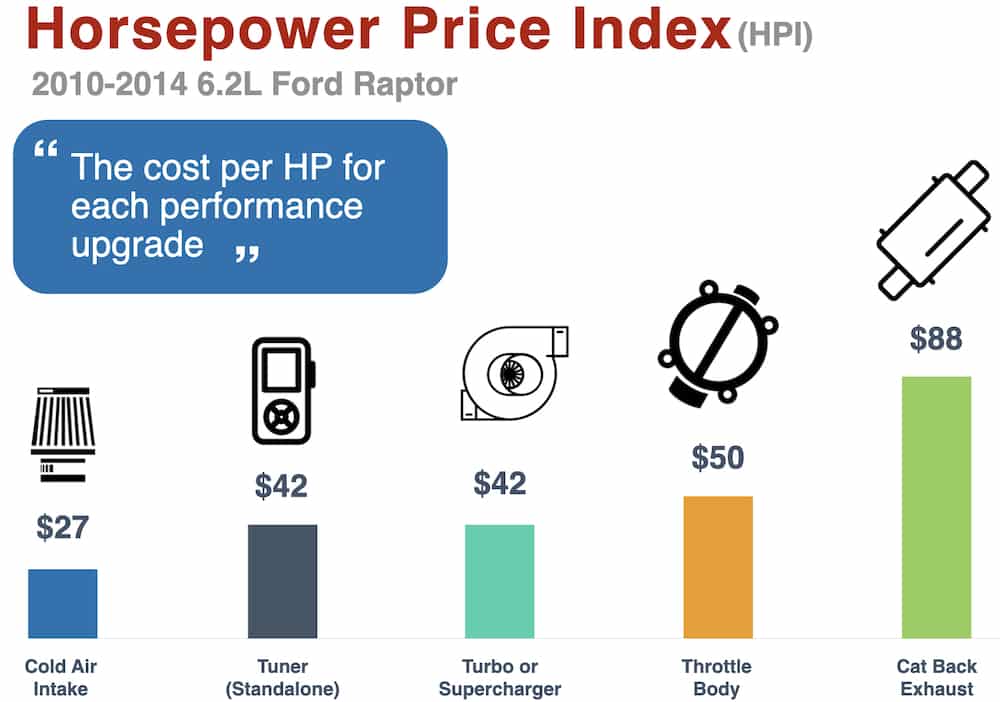
Cold Air Intakes for the win! A great cost effective go to mod that has the lowest cost per horsepower at just over $27. That is a 64% more horsepower for every dollar spent than a supercharger (forced air induction) and 240% better value that a cat back exhaust system.
All categories tested and represented are Cold Air intakes, Handheld DIY tuners, Forced Air Induction (Supercharger and turbocharger kits), Throttle body upgrade and Cat Back exhaust systems.
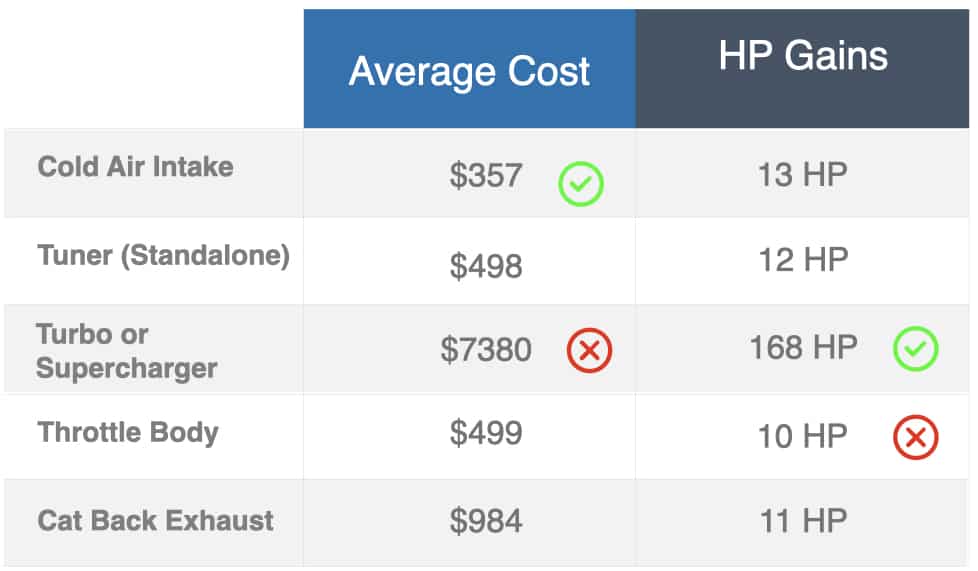
Cost per modification
Intake take the win again with the lowest cost entry point. There are a number of upgrades between the 1k and 7k price point but unfortunately not a lot of publicly available verified horsepower numbers
HP Gain Per Modification
Intakes take second place with a 13+ hp gain but an obvious first place goes to Forced induction with and average +168 HP gain. Thats a full 50% HP gain over a stock ford raptor
Independent and Not Combined
All item of these modifications we evaluated independently of each other as the only modification added to the truck. This means you cannot add the HP or TQ gain from each to be the result of both together. As we said its not an exact science so any combination of parts will result in different HP gains.
Our Recommendations (for a 2010-2014 6.2L F150 raptor)
1. Cold Air Intake
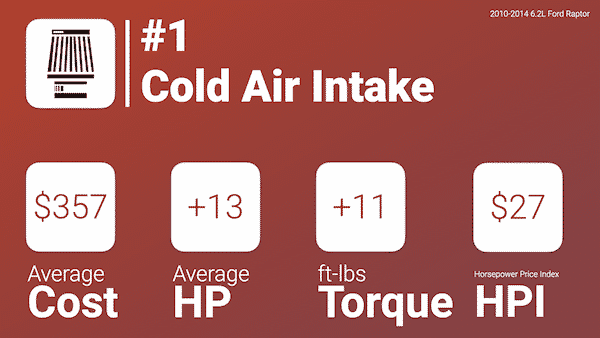
$357 | +13HP |+11 lb-ft Torque | $27 per HP
Cold air intakes have a pretty bad reputation as viable Ford Raptor performance upgrades on most Raptor web forums because they have lower hp gains than other bolts. They may not be considered to be “high performance”.
We feel confident that our data is pretty sold and the number do lie. We found dyno data from 5 separate intake systems, and while some of them are not on the market any more, the data is very clear, there is non other Bang for you Buck, horsepower adding value. Cold Air Intakes add 1hp for every $27 spent on average.
Yes there are higher horsepower options to add to your truck but a cold air intake tested as not old the cheapest cost per HP but the second highest total power gain in our comparison group. We have even seen gains as high as +40hp when you combine it with a tuner.
This is a clear indicator of the potential of just letting your engine breath a bit. Just remember that if most supercharger or turbo charger kits come with a custom cold air intake. This means you should pass on this mod if you place to do forced air induction.
Finally the best part is this is one of the most simple Ford Raptor performance upgrades you can get and install, so don’t stress about hiring a mechanic on this one.
The Pros
- Low cost
- Most HP for dollar
- Simple Installation
The Cons
- Generally not compatible with a forced air induction kit
- Not the largest HP gain solution
2. Stand Alone Tuner
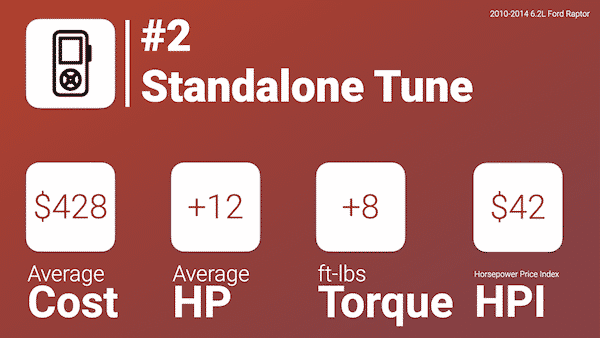
$428 | +12HP |+8 lb-ft Torque | $42 per HP
A Stand Alone Tuner is dropping shipped tuner you plug into the OBD2 port of your truck. This allows you to “flash” or modify the existing tune on your truck yourself. DIY means no professional training no expensive dyno session and no tools required for this one. Just plug it into the port under you dash and follow in included instructions.
One great benefit of having your own tuner is you can have multiple tunes that you switch between. high performance tune, Gas saving tune and even a towing tune with hauling a trailer. And while the hp gains we have are a result of just a tune with no other modifications.
Most places can add custom tunes after the fact when you buy other upgrades. This allows you to optimize and increase the HP for each performance modification. This Ford Raptor performance upgrade is definitely a HP multiplier for everything else you bolt on.
The Pros
- No Special tools Needed (Easy Install)
- Good Bang for Buck
- Flexibility for separate high performance, towing and economy modes
- 10-20% more horsepower from other mods
The Cons
- Lowest torque gains
3. Supercharger Kit
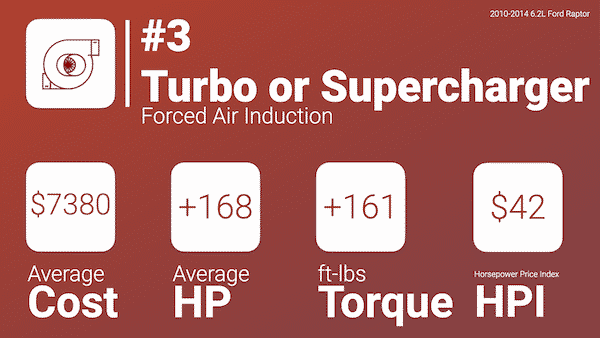
$7380 | +168HP | +161 lb-ft Torque | $42 per HP
You get what you pay for with forced air induction. Highest costs but also the highest HP gains. Cherry on top is that it has a very reasonable cost per horsepower. With an average horsepower gain of 168 HP this Ford Raptor performance upgrade will give your 6.2l more than a 50% power boost.
We found data for all 3 types of forced air induction systems sold for the 6.2l F150 raptor motor, Roots style supercharger system (Rough & Whipple), centrifugal (Pro Charger), and Turbo (Hellion).
The Pro Charger kit wins the Cost per HP at $35 but the whipple kit seem to be top seller in the raptor community.
Turbos are general capable of generation more boost and don’t have the hp drain superchargers have, you have to remember the 6.2l raptor motor is already a higher compression engines that has it limits in how much boost it can handle reliably. Whipple kit claims thier new kit only required 1hp drain at idle… and for the price it’s a solid option and value.
Just like the tuner, getting a forced air induction system is a HP multiplier for your other systems. HP is all about moving more air in. So if its and intake system or a exhaust they will help make more power per bolt on with a forced air system than on a stoke motor..
The Pros
- Largest single bolt on HP & torque increase
- HP multiplier for current and future bolt ons
The Cons
- Largest up front costs
- Difficult installation may require a professional
4. Exhaust
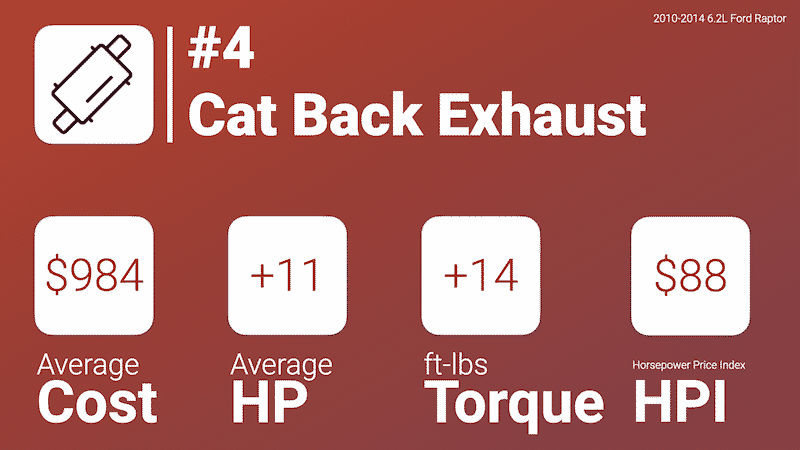
$984 | +11HP | +14 lb-ft Torque | $88 per HP
After seeing these shocking results of high cost exhaust systems for the horsepower gain you get we probably would have left them off if it were not for THE SOUND!
An exhaust system can truly transform your truck giving it a mean aggressive and stand out in the crowd effect that just puts a smile on my face. I believe the higher costs per HP is mostly due to the fact that it is the largest upgrade in terms of the size of the part. This means the manufacturer has to factor in all the extra raw material costs to build it (lots of steel) and the cost to ship a custom kit to your door (very heavy and large in size). It’s an unfair advantage, and I’m willing to bet that if there was good data on true dual exhaust setups vs low cost single exit systems like MBRP, the cheaper single exit systems would win just due to the significant reduction in material costs.
The Pros
- The Sound!
The Cons
- Lowest # on the Horsepower Price Index (HPI)
- Not cheap
5 : Throttle Body
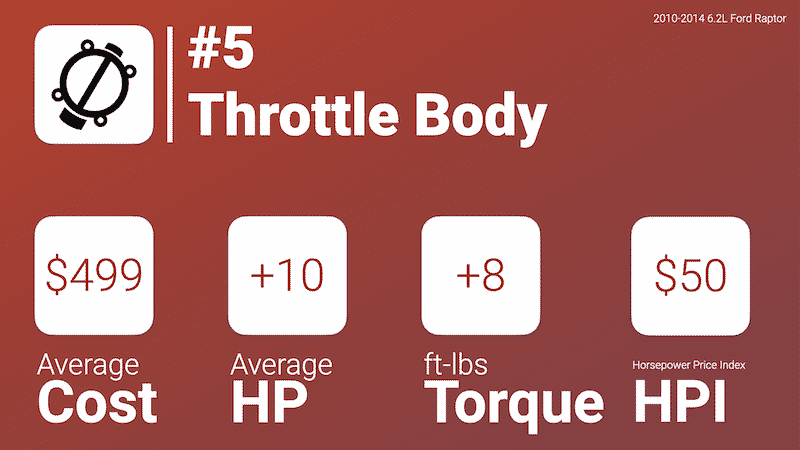
$499 | +10HP | +8 lb-ft Torque | $50 per HP
The BBK Throttle body makes the list (but is last) for 2 main reasons. One, it’s almost 2x the horsepower per dollar spent than an exhaust system and Two, it gets a pretty bad reputation for being a decent use of $500.
While it’s not the best bank for your buck, it does provide an increase in horsepower, torque and most importantly the “butt dyno” meaning you can immediately feel an improvement driving around town with this upgrade. The 6.2l motor is not known for having great throttle response and this Ford Raptor performance upgrade makes a huge improvement to it.
The Pros
- Improved throttle response
- Middle of the pack Horsepower Price Index (HPI)
- Great for turbo applications
The Cons
- Generally not compatible with roots style supercharger setup
- Limited options on the market
Honorable Mention : Peddle Commander
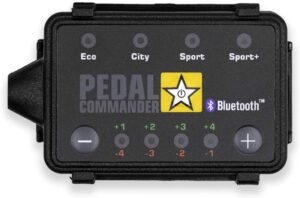
We had to give a shout out to this Ford Raptor performance upgrade because while it doesn’t add any horsepower it does bring a smile to your face in terms of noticeable power. As mentioned earlier when discussing throttle bodies, the 6.2l Motor is known for having poor throttle response. It has been speculated that the drive by wire throttle never opens to 100% even with your foot to the floor until higher RPMs for fuel efficient or torque optimization reasons.
The peddle commander modifies the drive by wire signal from the pedal to the throttle body and helps you to get true 100% throttle at any RPM. This is why people love it so much because it will wake up your motor with improved throttle response in any application. Around town, off-roading, towing.
The Pros
- Improved throttle response at 1/2 the price
- Settings for eco, performance and towing like a tuner
The Cons
- No HP gains
- Obsolete if you get a tuner
Make sure and check other great reviews such as f150 headlights, f150 third brake light, f150 tailgate shock or f150 floor mats.
You May Also Like
Sample Data Collected
Baseline Horsepower Dyno: Datapoint 1, Datapoint 2, Datapoint3, Datapoint 4
Cold Air Intake Data: K&N , AirRaid , Hennnesy , BBK, JLT
Tuner Data: SCT Livewire, SCT Handheld, SCT with 5 star
Forced Induction: Roush , Whipple , Turbo
Cat Back Exhaust Data : Gibson , Corsa , Rebel 3″
Throttle Body Data : BBK
Keep up on our newest article by visiting our Homepage
